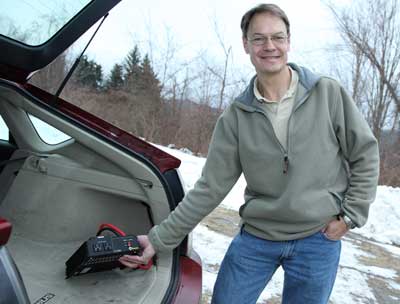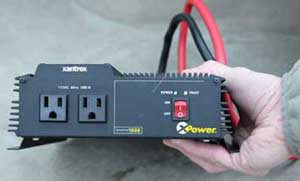You can of course connect any inverter to the 12 volt battery of any vehicle and use AC output. The problem with using the alternator of a standard family saloon is that it is very inefficient. Most vehicles will only output around 300 watts and is insufficient to keep fridges and freezers running.
The energy density of 1 litre of petrol is about 8.7 kWh/L. In a standard vehicle the alternator can output between 300 - 700 watts. ( 1.5 - 7 amps at 12 volts depending on the condition of the alternator). You will also need to keep the vehicle's engine running continuously.
In the Prius, the Dc/Dc converter outputs about1300 watts to charge the 12 volt battery. The High Voltage Battery has a capacity of 1500 watts. As the capacity of this battery is drained down to 50%, the petrol engine will switch on to charge the HVB and switch off when the HVB it is fully charged.
You can connect any 1000 watts inverter to the battery of the hybrid car to use it as a generator to provide emergency power in a blackout or any place where you do not have access to mains power. There is no danger of engine overheating as it will shut down as soon as the HVB battery is fully charged. There is enough power to keep your fridges and lights running in an emergency.
You can also use this setup in your prius to run computers and instruments "on the go". If you do this you should use a sine wave inverter or you may cause damage to your sensitive equipment.
Below is an example of a situation where this feature was used in a blackout.
[ #priusgenerator - http://bit.ly/VRtz6y ]
For more information visit The Battery Clinic Ltd
_______________________________________________________
Pressed for Details: Hybrid car powers home during blackout
The energy density of 1 litre of petrol is about 8.7 kWh/L. In a standard vehicle the alternator can output between 300 - 700 watts. ( 1.5 - 7 amps at 12 volts depending on the condition of the alternator). You will also need to keep the vehicle's engine running continuously.
In the Prius, the Dc/Dc converter outputs about1300 watts to charge the 12 volt battery. The High Voltage Battery has a capacity of 1500 watts. As the capacity of this battery is drained down to 50%, the petrol engine will switch on to charge the HVB and switch off when the HVB it is fully charged.
You can connect any 1000 watts inverter to the battery of the hybrid car to use it as a generator to provide emergency power in a blackout or any place where you do not have access to mains power. There is no danger of engine overheating as it will shut down as soon as the HVB battery is fully charged. There is enough power to keep your fridges and lights running in an emergency.
You can also use this setup in your prius to run computers and instruments "on the go". If you do this you should use a sine wave inverter or you may cause damage to your sensitive equipment.
Below is an example of a situation where this feature was used in a blackout.
[ #priusgenerator - http://bit.ly/VRtz6y ]
For more information visit The Battery Clinic Ltd
_______________________________________________________
Pressed for Details: Hybrid car powers home during blackout
 |
| John Sweeney with the inverter that allowed him to power his home with his Prius during the recent power outage after the Dec. 11 ice storm. (Photo by Lisa Aciukewicz) |
Our summer house is a sailboat and we power it completely with the power of the wind. On the sailboat, we have two windmills that charge very large 12-volt batteries. We run the refrigerator, lights, computer, and navigation electronics from this stored energy. Part of the system is a large inverter that takes 12-volt direct current (DC) and creates 120-volt alternating current (AC), the same as standard household power. We use the 120-volt AC to run many appliances exactly as we would at home, such as a microwave oven, cell phone chargers, rechargeable flashlights, and standard laptop power adapters.
At home, we are very energy conscious, and we have a whole-house electric meter that sits on the counter in the kitchen, as well as several small “kill-a-watt” meters to measure the power used by individual appliances. Simply by being aware of our power usage, we cut our electric bill by roughly $50 per month.
With this background, it seemed like using the Prius along with an inverter would be a simple and cost-effective solution to our power-outage problem.
The 12-volt system in the Prius is slightly larger than that in a normal car because all the accessories such as coolant pumps and power steering are electrical rather than driven off the engine.
 |
Because an inverter uses quite a bit of current, I put it close to the 12-volt source and used large diameter wires. In the 2004 and later model years, the 12-volt battery is located in the rear of the car on the passenger side, so I wired the inverter directly to the 12-volt battery, attaching the wires right to the bolts on the battery posts. This location also has an easy way to route the fat 12-volter wires, and leave the inverter sitting in the hatchback area semipermanently.
I ran a long high-capacity extension cord from the 120-volt plug on the inverter into the house. Inside the house I plugged the “kill-a-watt” meter into the extension cord to make sure I wasn’t over the 1,000 watts the inverter/Prius could supply. From there, I plugged in the refrigerator and freezer that were stuffed full of our frozen food for Christmas dinner (remember that this was a freezing-rain storm, and because the temperature varied around freezing we could not simply put this food outside as many bloggers have suggested). In addition, we ran the woodstove fan, the TV (we get over-the-air HDTV so it didn’t matter that the cable system was out), and several lights at night.
In the Prius, I put the car in “ready” mode, which means it is completely on and ready to drive. I left it in park and applied the emergency brake. I also turned off all accessories, particularly the climate control system, headlights, and stereo because these use the most power. In this mode, the car is fully on, and the gasoline engine will start if the drive battery voltage gets low due to the draw on the 12-volt system. If the climate control system is on, the car will run the engine if it senses the need for heat or cooling.
In this mode, the gas engine ran roughly five minutes every half hour to charge the drive battery. Over the four days we ran the house from the Prius, we used about 17 kilowatt hours of energy, and the car burned about five gallons of gas.
This could have been done using a nonhybrid car, but it would also have to be on, which means the gas engine would be idling constantly. My other car uses about a half gallon per hour idling, so if a normal car had been used it would have burned 40 gallons of gas during the 80 hours of “emergency generator” usage.
I am not the first person to use the Prius in this manner, and I would like to give credit to the other folks in the Prius technical community who have done the research making this possible. Bob Wilson wrote up the same technique for the second-generation Prius (http://home.hiwaay.net/~bzwilson/prius/priups.html). “Hobbit” used an uninterruptible power supply tied into the current, third-generation Prius to run a sump pump (http://www.cleanmpg.com/forums/showthread.php?p=25346). “Hobbit” also explained how to change the 12-volt battery in the third-generation Prius and provided some good pictures of the battery location and hookup (http://www.techno-fandom.org/~hobbit/cars/prius-12V/ela/ela.html).
It would be possible to get much more power out of the car if you wanted to connect directly to the 200+-volt drive battery. However, this technique is probably best left to the car designers because they have the knowledge to design it safely and economically.
In summary, the Prius is ideally suited for use as an emergency generator, in addition to being a great car in its own right. I believe that this use of a car will seem normal in five to 10 years when we have plug-in hybrids and pure electric cars available to the general public. In addition, we will have implemented a “smart grid” that can charge the electric cars during nonpeak hours and potentially store renewable energy from intermittent sources such as wind and solar.
